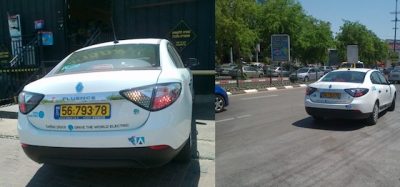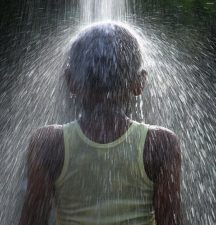 Following a site visit conducted as part of a meeting of geographers at Ben-Gurion University last week, Dr. Gotlieb reflects on how appropriate technology, bottom-up planning and goodwill are prerequisites to resolving conflict.
Following a site visit conducted as part of a meeting of geographers at Ben-Gurion University last week, Dr. Gotlieb reflects on how appropriate technology, bottom-up planning and goodwill are prerequisites to resolving conflict.
For an international group of geographers, a visit to what is known variously as Judea and Samaria, the West Bank – of the wizened Jordan River – or the Occupied Territories is bound to be a pithy event. As an Israeli geographer and environmentalist who has avoided the area for many years, my visit prompted new thinking on the Israel-Palestinian conflict: If there is any hope for a resolution, it will be found in cooperative planning of scarce, land-based resources.
Our visit to the southern Hebron hills and the Gush Etzion Bloc began with a visit to Meitar, a community known in current planning parlance as ex-urban, a “dormitory community” as Ben-Gurion University professor David Newman, described it during our early morning briefing. It is a placid community in the Negev near the southernmost tip of Judea, one whose residents work in the relative metropolis of nearby Beersheva or in major regional enterprises like the Israel Chemicals works.
Interestingly, there is no security fence around the community, which is a stone’s throw from the Occupied Territories and Israeli Bedouin encampments. There is a belt of forests and woodlands around Meitar planted by the Keren Kayemet (Jewish National Fund). It is a quiet, undisputed place, a Jewish community in the country.
A Virtual Border
We passed into the West Bank at the Meitar Checkpoint, a virtual border station between Israel and the Hebron Hills. The facility, which began operating in late 2008 is a state-of-the-art passage for people and goods between Israel and the Palestinian territories. Supervised and trained by Ministry of Defense personnel, operations at the site are run by a private security firm.
One is impressed by the order, proficiency and calm encountered at the station, which we visited just after the end of the four to seven am crunch when Palestinian workers arrive for work in Israel. Unlike other checkpoints, Meitar is staffed by security personnel in civilian dress and their bearing is professional, not martial. According to the director of security at the terminal, at least one security incident occurs at the facility each day. Catastrophe is averted by knowledge-based Israeli technology and a staff thoroughly drilled in security procedures and human relations.
Our next stop was in the an area described as the “lands of Susya,” approximately sixteen kilometers north and east of the Meitar terminal — a world away. Susya is in the parched south Hebron hills, part of the Judean wilderness, desert land that is gravelly with scrubby vegetation. There are a number of settler outposts here, most with a small number of caravans.
Much of the land is used for pasturage by local Bedouin, many of whose families left the town of Yatta — eight kilometers south of Hebron and now a major Palestinian city of seventy thousand people — and became cave dwellers a hundred years ago.
Ironically, though treated with disdain by the settlers these people are disparagingly referred to by the other Palestinians as the “Jews”; local lore has it that they are descendants of Jewish communities originating in the Arabian peninsula. Adding further to the entanglements of their existence, they have settled in a place where subsequent archeological excavation uncovered an ancient synagogue.
Whatever their origins, these Bedouin are subject to harsh conditions: difficult terrain where little cultivation can take place, a shortage of water, attacks by militant Jewish settlers, neglect by the Palestinian Authority and tough regimentation by the Israel Defense Forces: the latter claims they are intruders encroaching on the land it holds as part of Area “C,” according to the Oslo Accord designation.
Amid crushing conditions, these people live, tending small livestock and olive groves. Some have built houses, which are prone to demolition by the IDF as being “illegal.” One of their settlements has been “recognized” and IDF soldiers escort its children to school, protection against attacks suffered in the past by Jewish hooligans.
Because these lands are in dispute, the population is connected neither to the Israeli or Palestinian electricity grids or water or sewage systems. Israeli and international activists have provided these people with solar energy systems and wind-driven turbines that provide some relief for these people.
Behind the plots of olive trees ripe for development, sustainably
As I looked at these low-cost, green technologies against the backdrop of the terrain, the Bedouin tents and the small plots of olive trees, it occurred to me that areas like this are place ripe for sustainable development — if they can avoid “modernization.”
Where planners and economists might counsel building roads, industry and other trappings of market-driven growth for marginal areas, it is clear that low-impact agriculture, agro-forestry, and sheep herding fueled by passive energy sources and other appropriate technologies could provide a sustainable livelihood for the local population. The application of drip irrigation, solar collectors and other earth-friendly systems – the kind of technology in which Israel is a world leader — could help these people make a living out of these hard lands.
As I heard the stories of harassment and disregard I understood of course that appropriate technology for low-impact agriculture is a necessary but insufficient conditions to help these people live sustainably. No less imperative is the need for a more benevolent spirit to blow over these lands.
Micro-Climates and Eco-Zones
We left Susya and the desert lands behind and proceeded toward Hebron. Within a quarter of an hour one is reminded of how varied the Land of Israel/Palestine is in terms of micro-climates and eco-zones. The transition from blazing, stony desert to more moderate temperatures and arable terrain takes place rapidly and in a matter of kilometers. As we drove we noticed tiers of ancient terraces, neat plots cut into the side of the mountains. A sustainable form of agriculture had once been practiced here. I wondered if there might be lessons, or at least hope in this for the beleaguered souls we had just visited in the lands around Susya.
We circumvented the Jewish settler city of Kiriat Arba and Hebron itself and skirted a refugee camp, now something between a shanty town and a city neighborhood and headed to our next destination. Gush Etzion is a short drive north of Hebron on Route 60, the major highway that runs the length of the West Bank.
There we were hosted by Shaul Goldstein, the mayor of the Gush, a small region consisting of eighteen communities and a population of nearly 44,000 people. Originally settled by Yemenite Jews and religious migrants from Jerusalem in 1927, it stands between Hebron and Jerusalem, ancient cities of the Jewish heartland. In the period since then the bloc fell three times to Arab assaults including a May 1948 massacre during which 240 Jews were killed, a similar number taken captive by the Jordanian Legion and the settlements razed.
After Israel captured these lands following the 1967 war many of the children of the original settlers and others returned. Today it is a bustling area of planned settlement, learning, and a tourist destination within easy reach from central Israel.
I was struck by some graffiti I saw on one of the walls of a passageway near where we had eaten lunch: “I am proud to be a Jew,” was what it read. No anti-Arab vitriol. And that set the tenor for the rest of our visit, a kind of definition of what encounters in Gush Etzion: pride in heritage without chauvinism.
A Different Voice
As someone who does not support the settlers movement, I was leery of what the mayor might say to our group, an assembly of prominent geographers from around the world. I learned that Goldstein is a member of the Likud and does not believe in a two-state solution – but contrary to my expectations he expressed views in vivid contrast with those of the militants the media brings to home television screens around the world.
Goldstein and Carter
Goldstein is the man with whom Jimmy Carter, no champion of Israel, met during his June 2009 visit to the area. For several hours, Carter visited Goldstein at his Neve Daniel home in the Gush and emerged to say “I have been very fortunate this afternoon in learning a perspective that I didn’t have,” and that “this particular settlement area is not one that I envision ever being abandoned or changed over into Palestinian territory.”
The perspective that Shaul Goldstein espouses is one of coexistence and partnership with his Palestinian neighbors based on mutual respect. He condemns settler violence against Palestinians or their property and has an ongoing dialogue with his Palestinian counterparts concerning joint development of the area. A subject of protests by Jewish extremists, Goldstein is convincing in his profession of a desire for peace.
He seeks coexistence built from the “bottom-up” that will determine the future political contours on the basis of mutually beneficial development for both Israelis and Palestinians in their adjacent communities. He cited the recent opening of a supermarket frequented by both area Arabs and Jews.
Goldstein is by his own description a politician and, accordingly, healthy skepticism is warranted in assessing his message. However, by the end of the tour of the Gush there is no doubting the respect evident for green spaces, healthy living and community – the kind of regard one encounters with a progressive vision.
While disagreeing with Goldstein’s politics it is difficult to find fault with his perspective: A bottom-up approach to bridge building seems to me correct, more effective than imposing solutions from above – whether from the Government Precinct in Jerusalem, the Mukhta, the seat of the Palestinian Authority in Ramallah, or the cynical resolution makers at the UN along Manhattan’s East River.
Lessons of the Day
During a day away from news reports of violence and threats, there was a sense that maybe there is hope for progress. Both Jewish and Palestinian roots run deep in these sore lands. Rather than focusing on uprooting the other, both parties would do well to cultivate common ground using adaptive technology and by combining scientific know-how and traditional land-management practices in a framework where cooperation, not competition, is fostered.
Image via amerune



